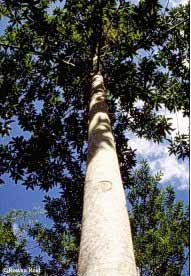|
|
|
Managing
individual trees for sawlogs

Timber production is only one reason farmers
establish forests and plantations. Many farmers manage mixed
species or mixed age forests to produce a range of products
and services. For these farmers it might be more viable to manage
individual trees within their forest for timber rather than
the whole plantation. The emphasis must be on high quality to
ensure that trees are viable to harvest. Pruning, culling and
managing competition from other trees in their forest will help
ensure a viable harvest.
Promising trees located in areas with easy access for harvesting
could be pruned. Immediately after each pruning it is important
to make sure the tree is under competition from adjacent trees
or vegetation for light, water and other resources. Examining
the forest canopy is the simplest way to assess competition.
If the pruned tree is overtopped by nearby trees, then those
trees should be culled. Another relatively simple way to assess
competition is to use the spacing factor. The aim is to ensure
that the selected tree’s canopy can develop freely.
If, for example, the farmer wanted to reduce the competition
in their forest down to a basal area of 10 m2/ha to promote
diameter growth the spacing between trees of a similar diameter
would need to be about 30 times the diameter. For example, if
the trees were all around 15 centimetres in diameter, then culling
any tree within 4.5 metres—15 cm x 30 cm = 4.5 m—would
reduce the basal area to less than 10 square metres per hectare.
As the trees grow they will require more space.
In a mixed-age forest, where the trees are different sizes,
the same technique can be used to determine if a large tree
near the selected tree should be culled. If it is located within
30 times its own diameter, then it might be assumed to be competing
with the selected tree. For farmers comfortable with using a
basal area wedge, assessing competition levels is simple. A
farmer stands beside the selected tree, estimates the basal
area using the wedge—including the selected tree in the
count—and can use this as a measure of the level of competition
affecting that tree. If it is more than the desired level of
competition for the species on that site, the sweep could be
repeated excluding trees that might be culled.
Tree and
forest measurement
Back to top
|
|
